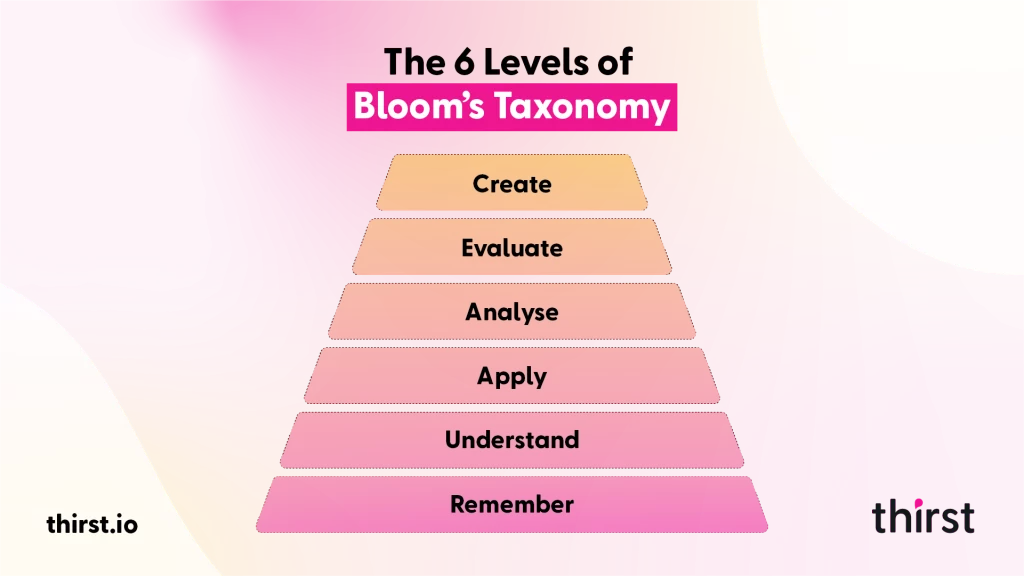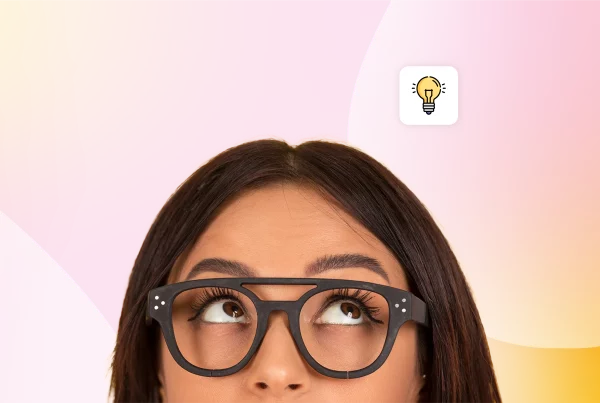Day to day, you’re probably knee-deep in designing training programs, developing e-learning content, and levelling up those all-important employee skills.
We know you love preparing your organisation to learn better, but did you know Bloom’s Taxonomy can help you structure learning objectives like a pro?
That’s right! There could be some learning here for you, too!
Bloom’s Taxonomy is one of the most widely used frameworks in education and corporate learning. Maybe you’ve heard of it before but aren’t 100% sure what it’s all about.
Or maybe you’re just curious to dive deeper. Either way, you’re in the right place!
In this guide, we’ll break it all down: what Bloom’s Taxonomy is, its history, the six cognitive levels, and how YOU can use it to create powerful training programs in 2025.
Let’s go! 🚀
What is Bloom’s Taxonomy? 🤔
In simple terms, Bloom’s Taxonomy is a framework that ranks learning objectives based on cognitive complexity.
Who Created Bloom’s Taxonomy? 👨🏫
Back in 1956, Benjamin Bloom and his team of educational psychologists created this structured approach to help learners move from basic knowledge recall to deep, critical thinking.
Why Does Bloom’s Taxonomy Matter? 🎯
At a glance…
- It helps create structured learning objectives.
- Boosts skill development in corporate training.
- Enhances critical thinking and problem-solving.
- Supports L&D teams in designing practical, results-driven learning experiences.
Sounds good, right?
A Quick History Lesson 🕰️
The Origin & Purpose
As we noted above, Benjamin Bloom developed this framework in 1956 to standardise learning objectives and shift focus from rote memorisation to deeper understanding.
The 2001 Revision
Fast forward to 2001, and researchers updated the taxonomy to align with modern learning theories. (It may be due to another revision, as it has been a while!).
The key changes included a shift from noun-based categories to action-oriented terms. For instance, “Comprehension” became “Understand”, and the order of the levels were rearranged, with “Create” becoming the highest level, replacing “Evaluate”.
Stay with us. Things are about to get clearer!
We’ve kept our examples quite broad as you may be joining us from any number of industries, from finance to healthcare! The key is to make the framework suit your organisation’s goals.
The 6 Levels of Bloom’s Taxonomy (And Crucially…How to Use Them) 📚
1. Remember – Recall basic facts & concepts. 🧠
Actions: Define, Identify, Recall, Recognise.
Examples:
- Identify workplace safety procedures.
- List the steps in the company’s sales process.
- Recognise key compliance regulations in your industry.
2. Understand – Explain ideas & concepts.💡
Actions: Describe, Explain, Interpret, Summarise.
Examples:
- Describe how your company’s values align with its business strategy.
- Summarise the benefits of a new software tool for your team.
- Explain the importance of cybersecurity best practices.
3. Apply – Use knowledge in real situations. 🚀
Actions: Demonstrate, Execute, Use, Implement.
Examples:
- Use conflict resolution techniques in a team meeting.
- Apply time management strategies to boost productivity.
- Implement a new project management framework such as Agile or PRINCE2 in your department.
4. Analyse – Draw connections between ideas. 🔍
Actions: Differentiate, Organise, Compare, Examine.
Examples:
- Compare the effectiveness of two different leadership styles.
- Break down customer feedback to identify recurring themes.
- Examine training data to determine areas for improvement.
5. Evaluate – Justify decisions & opinions. ⚖️
Actions: Judge, Critique, Justify, Support.
Examples:
- Assess whether a new training program meets employee learning needs.
- Justify a decision to invest in a specific learning platform.
- Critique a recent marketing campaign and suggest improvements.
6. Create – Build something new & original. 🎨
Actions: Construct, Invent, Formulate, Design.
Examples:
- Develop a mentorship program for new employees.
- Design an interactive e-learning module for product training.
- Build a new strategy for remote team engagement.
Why Should L&D Pros Use Bloom’s Taxonomy? 🤩
For L&D Teams
✅ Helps design training that enables real learning.
✅ Aligns training with your business goals.
✅ Makes learning outcomes measurable.
For Educators & Instructional Designers
✅ Structures lesson plans effectively.
✅ Keeps learners engaged through progressive challenges.
For Corporate Learners
✅ Builds critical thinking and problem-solving skills.
✅ Enhances career development and job performance.
Applying Bloom’s Taxonomy in L&D 🚀
- Structure Training Programs – Start with the basics, then build toward advanced problem-solving and creativity.
- Enhance E-learning & AI-Powered Learning – Platforms like Thirst use Bloom’s Taxonomy to personalise learning and track skill progression.
- Align Learning Objectives with Performance Goals – Ensure training supports career growth and business success.
The Limitations of Bloom’s Taxonomy ⚠️
Despite its strengths, it’s not perfect (When is anything ever perfect!)
- Too Linear – Learning isn’t always step-by-step.
- It ignores emotions and doesn’t consider motivation or engagement.
- Other Models Exist – Like SOLO Taxonomy & Anderson-Krathwohl’s Revised Taxonomy.
If you’re interested in learning more about those, let us know, and we can create a guide!
Final Thoughts 💭
Bloom’s Taxonomy is STILL one of the best ways to structure L&D programs.
Did you know that Thirst’s AI-powered learning experience platform was designed to enhance workplace learning and development in a user-friendly way?
Here’s a quick note on how Thirst can help implement Bloom’s Taxonomy in your L&D strategy
1. Personalised Learning Paths Based on Cognitive Levels
Thirst uses AI to curate and deliver personalised learning experiences.
Aligning your content with Bloom’s Taxonomy ensures your employees progress through learning stages, from Remembering foundational knowledge to Creating innovative solutions.
2. AI-Driven Content Curation & Delivery
Instead of generic training, Thirst recommends tailored resources (videos, articles, courses) based on an individual’s learning progress.
This approach helps learners move from understanding concepts to applying them in real-world scenarios.
3. Interactive Assessments & Knowledge Checks
Using quizzes and scenario-based questions aligned with Evaluate and Analyse, Thirst’s quiz feature ensures learners absorb information and critically engage with it.
4. Real-World Application & Skills development
With Thirst’s on-the-job learning recommendations, employees can move beyond theory and practice skills in real-time. This supports the Apply and Create levels of Bloom’s Taxonomy.
5. Data & Analytics for Measuring Learning Impact
Thirst provides insights into engagement, completion rates, and knowledge retention. This helps L&D teams assess whether learners progress beyond basic recall to higher-order thinking.
Get the most out of your L&D with Deep Data Insights & Analytics.
6. Social & Collaborative Learning
Create a culture of collaboration. Learners can engage in discussions, share insights, and receive feedback promoting Analysis and Evaluation through peer learning and mentorship.
By leveraging Thirst, you can implement Bloom’s Taxonomy in a scalable, AI-powered way, making workplace learning more structured, engaging, and effective. 💥
If this sounds good to you…Take a guided tour today and see Thirst in action!
For more e-learning insights, resources and information, discover the Thirst blog.
You may also enjoy:
13 Of The Best Coaching Models to Use | 24 Examples of Employee Strengths and How to Develop Them | What is Adaptive Learning: A Beginner’s Guide








